Courtyard Garden
This garden features a large tiered fountain in the center, providing an excellent guest photo opportunity.
Overview of Courtyard Garden
As you stroll through the winding pathways of the Gardens while visiting the Creation Museum, you will encounter a beautiful juncture at the Courtyard Garden. This garden features a large tiered fountain in the center, providing another excellent guest photo opportunity. A sitting wall has been added around the fountain to offer a wonderful place to sit and relax while taking in God’s creation. The Courtyard Garden features flowering hydrangeas, magnolias, roses, and golden rain trees along the path. Many seasonal flowers all around the garden supply additional texture and color, making this garden a thoroughly enjoyable experience.
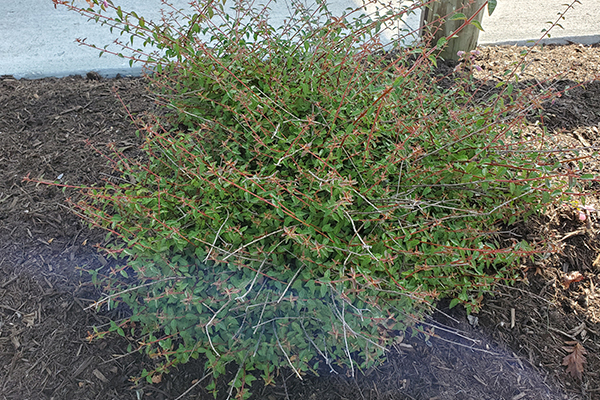
Pinky Bells Glossy Abelia
Common Name: Pinky Bells Glossy Abelia
Botanical Name: Abelia grandiflora
Height: 2–3 feet
Spread: 3–5 feet
Location: Full sun to part shade
Bloom: May–September, pinkish white flower
Hardiness zone 6–9
Pinky Bells grows more densely and in a smaller mound of glossy foliage than other abelia, making it an excellent choice for bed edges or smaller groupings. The new growth emerges in a red color, adding to your landscape display, then turns a shiny, medium green for the summer. The plant produces trumpet-shaped pink flowers that last from mid-summer into the fall season. Prune in late winter to early spring, as needed, because it flowers on the new spring growth.
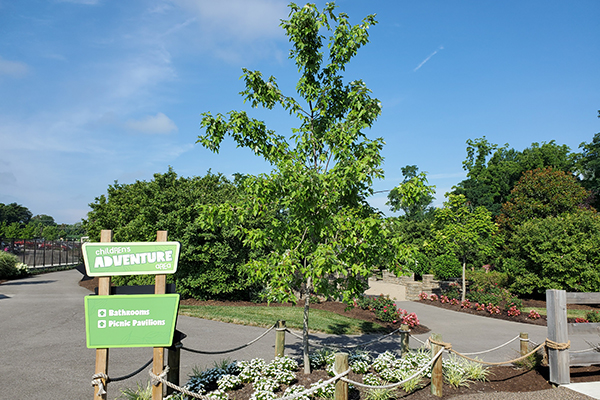
Autumn Fantasy Red Maple
Common Name: Autumn Fantasy Red Maple
Botanical Name: Acer freemanii
Height: 40–55 feet
Spread: 30–40 feet
Location: Full sun
Bloom: March, red flower
Hardiness zone 3–9
Autumn Fantasy is a hybrid maple created by crossing a silver maple with a red maple, taking the best characteristics of both low-maintenance shade trees. It has clusters of bright red flowers along brick-red branches that develop in spring, adding early interest to your landscape. The leaves emerge green and persist through the summer before changing into fall colors that vary from orange to a bright red. No serious disease or insect problems make this tree very easy to care for.
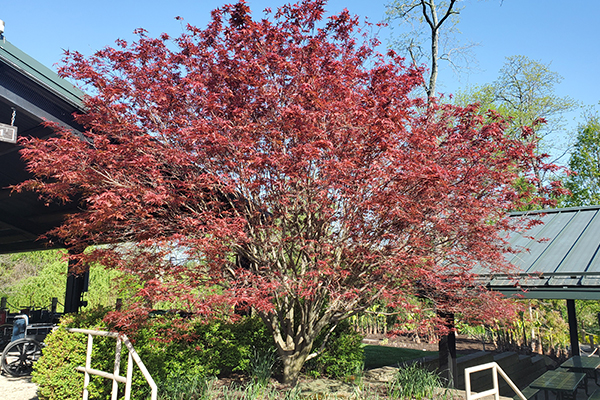
Moonfire Japanese Maple
Common Name: Moonfire Japanese Maple
Botanical Name: Acer palmatum
Height: 15–20 feet
Spread: 10–20 feet
Location: Full sun
Bloom: April, red flower
Hardiness zone 5–9
Moonfire maple has foliage that emerges dark purple and stays a dark burgundy color through the season. In the fall, the leaves turn bright red and really stands out. In fact, the translucent nature of the leaf gives the appearance of fire when the sun or moon is in the background—hence, the name. A favorite feature of this plant is the beautifully colored samaras commonly known as “helicopter seeds.” They are red, yellow, and brown and are a very interesting fall addition to this maple.

City Slicker River Birch
Common Name: City Slicker River Birch
Botanical Name: Betula nigra
Height: 30–60 feet
Spread: 20–50 feet
Location: Full sun to part shade
Bloom: April–May, brown and green catkins
Hardiness zone 5–9
City Slicker is a newer River Birch variety with a highlighted feature of creamy white bark that is somewhat papery. The tree canopy is normally about 3 feet off the ground without pruning, and the leaves are a deep, glossy green that turn to bright gold in the fall. This is a relatively low-maintenance tree that has also proven to be deer resistant. Use as a specimen or in a grouping in your landscape.
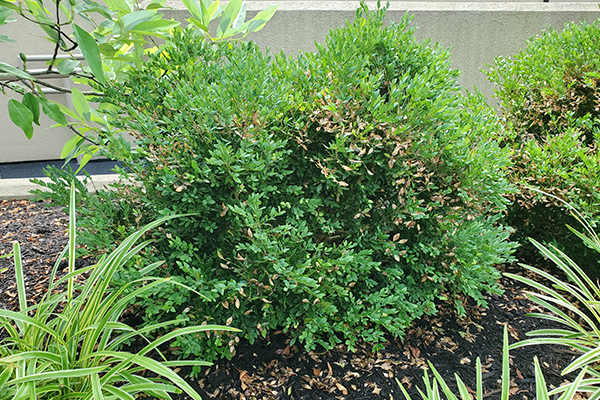
Green Velvet Boxwood
Common Name: Green Velvet Boxwood
Botanical Name: Buxus
Height: 3–4 feet
Spread: 3–4 feet
Location: Full sun to part shade
Bloom: Insignificant
Hardiness zone 4–9
Green Velvet is a wonderful evergreen that has a natural rounded form with no pruning required except to remove any damaged or dead branches. It keeps its color through the winter but can turn a brownish yellow from dehydration if planted in a windy spot. It only grows 3–4 foot in maturity and can give structure and a foundation to any garden. Boxwood is often used as a hedge, in a border, or as a background for a smaller garden.
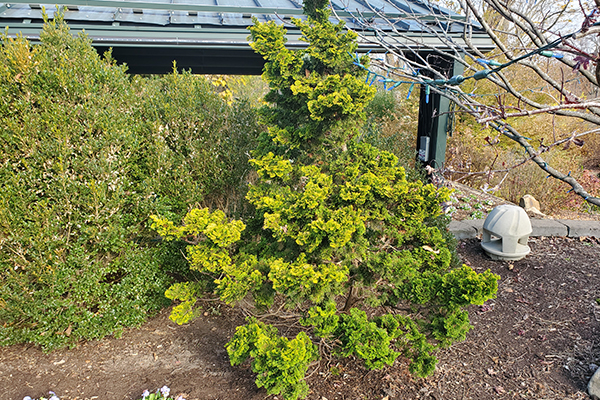
Dwarf Golden Hinoki Cypress
Common Name: Dwarf Golden Hinoki Cypress
Botanical Name: Chamaecyparis obtusa nana lutea
Height: 3–6 feet
Spread: 3–9 feet
Location: Full sun to part shade
Bloom: non-flowering
Hardiness zone 4–9
This dwarf variety of Hinoki is slow growing and typically only grows to an average 5-foot mature height. It forms a narrow pyramid as it matures, like ours in the small courtyard. The fan-shaped foliage has overlapping layers with the outer being a golden yellow to more of a lime green if planted in a shady area. It requires very little pruning, and it is best to prune only broken or dead branches. This is a perfect small specimen tree for your landscape. You could also put one in a planter to move around as desired.

Kentucky Coffee Tree
Common Name: Kentucky Coffee Tree
Botanical Name: Gymnocladus dioca expresso
Height: 60–75 feet
Spread: 40–50 feet
Location: Full sun
Bloom: July–September, pink and white flower with red center
Hardiness zone 3–9
The large, compounded leaf of the Coffee tree gives it a distinct tropical look, but it is a Midwestern US native. It is a tall, deciduous tree with rough, scaly brown bark, and it has an interesting story. The name derives from early settlers roasting and grinding the seed pods for coffee. The pods are very toxic prior to roasting, so they should never be eaten fresh. No serious insect or disease problems are noted with the Coffee tree, so it is an easy-to-care for native that adds interest to any garden.

Obsidian Coral Bell
Common Name: Obsidian Coral Bell
Botanical Name: Heuchera
Height: 1–2 feet
Spread: .75–2 feet
Location: Full sun to part shade
Bloom: June–July, white flower
Hardiness zone 3–9
Obsidian coral bell is one of many hybrids that have unique characteristics. The cool name means “dark-colored volcanic glass,” referring to the dark color that the leaf holds during the growing season. It grows in a clump form with small creamy white flowers that appear in late spring on slender stems well above the foliage. Used as an accent or in a border, it will add color to any garden all summer.

Bobo Hydrangea
Common Name: Bobo Hydrangea
Botanical Name: Hydrangea paniculata
Height: 3 feet
Spread: 3 feet
Location: Full sun to part shade
Bloom: July–September, white flower
Hardiness zone 3–8
Bobo is a dwarf variety that grows only to a height of three feet. It produces white flowers covering most of the plant all the way to the ground, brightening any spot in your garden. The flowers turn a pinkish color later in the season then to brown in the fall, giving this plant a long season of interest. They have very little insect or disease problems, so they do not require a lot of your time.
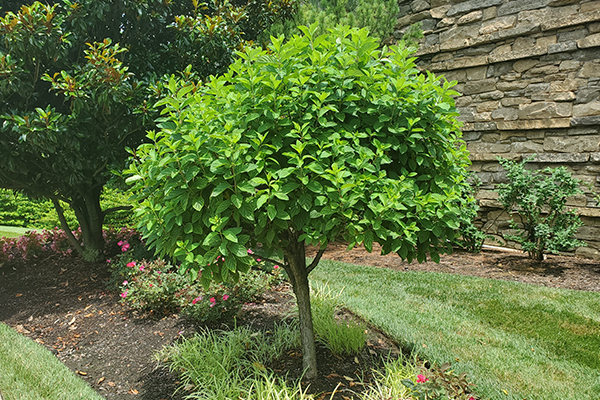
Tardiva
Common Name: Tardiva
Botanical Name: Hydrangea paniculate
Height: 8–12 feet
Spread: 6–10 feet
Location: Full sun to part shade
Bloom: July–September, white flower
Hardiness zone 3–8
Our Tardiva was trained to grow into a tree form from a young age with the primary plant grafted atop a “standard,” which is a single tree-root stock. It has many of the same growth habits as a shrub form, including the same showy white flowers that appear in July, then slowly turn a pinkish color with age. This is an easy-to-grow and easy-to-care for “feature” plant, or it can be a companion plant that gives you more height while requiring less space than the shrub version of the same plant.
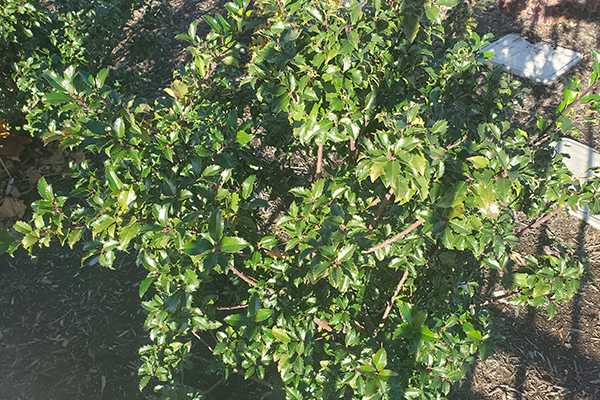
Blue Princess Holly
Common Name: Blue Princess Holly
Botanical Name: Ilex meserveae
Height: 10–15 feet
Spread: 8–10 feet
Location: Full sun to part shade
Bloom: April–May, white flower
Hardiness zone 4–8
The Blue Holly is an evergreen shrub with glossy blue-green leaves that give year-round appeal. It is dioecious, like most in the family, so you will need one male plant as a pollinator to have the beautiful red berries later in the year on the female plants. The growth rate is fast compared to other hollies, and it can get to 15 feet, so it is best used as a border, screen, or foundation plant.
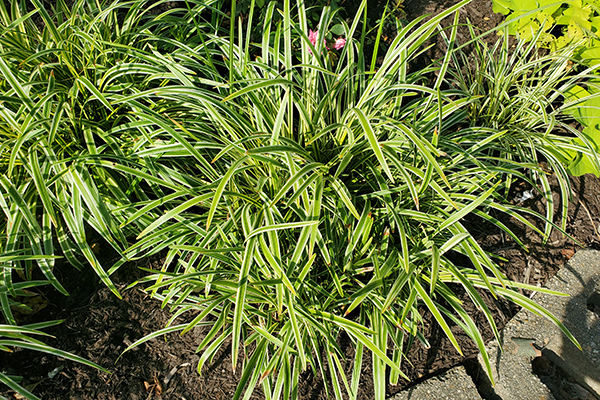
Variegated Lilyturf
Common Name: Variegated Lilyturf
Botanical Name: Liriope muscari variegata
Height: 1–2 feet
Spread: 1–3 feet
Location: Full sun to part shade
Bloom: August, purple flower
Hardiness zone 5–11
We love Liriope as a border plant, but we also use it in groupings throughout the Botanical Gardens. Be careful to read the growth habits for your liriope before planting. Our variegated variety “Muscari Variegate” grows in clumps increasing in size every year. Our solid green variety, “Big Blue,” is a ground-covering plant and will take over an area that you may not want. They look very similar in the pot when you purchase so we suggest reading before planting, as with all plants. Both types of Liriope have violet–purple flowers in late summer, giving way to black berries that persist into the winter. Both are perennials, so we cut them all the way back in the winter, and they return in the spring with new growth.

Jane Magnolia
Common Name: Jane Magnolia
Botanical Name: Magnolia
Height: 8–15 feet
Spread: 8–12 feet
Location: Full sun to part shade
Bloom: April–May, pinkish purple-white center flower
Hardiness zone 4–8
Jane is part of the little girl series of hybrid magnolias and normally grows to about 15 feet tall. They flower a little later in the spring than some other magnolias, reducing the risk of late frost damage. The oval-shaped leaves emerge after the flowers and turn from dark green to yellow bronze in the fall. Very little care is required, and it is disease and insect resistant.

Exclamation London Planetree
Common Name: Exclamation London Planetree
Botanical Name: Platanus acerifolia
Height: 55–60 feet
Spread: 35–45 feet
Location: Full sun
Bloom: April, yellow flower (male), red (female)
Hardiness zone 4–8
Exclamation is a variety of a planetree with a strong central leader and a higher resistance to disease than some others in the same family. The planetree is a close relative to the sycamore tree, and it can be difficult to differentiate between the two. Both trees are known for their outstanding white bark and its peeling characteristics. This is a large area tree, so give it room in your landscape.
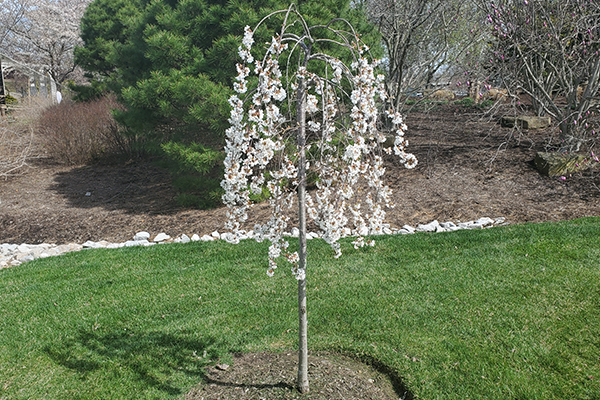
Snow Fountains Weeping Cherry
Common Name: Snow Fountains Weeping Cherry
Botanical Name: Prunus pendula
Height: 8–15 feet
Spread: 6–8 feet
Location: Full sun
Bloom: April, white flower
Hardiness zone 5–8
A weeping cherry tree is considered a specimen tree with its pendulant branches that are covered with flowers in the early spring before the leaves emerge. The ornamental cherries have a good resistance to disease, but they are still susceptible to a variety of insects and may require some care. They also have shoots that grow around the base known as “suckers” that will need to be pruned off. This small amount of work is usually considered well worth the effort to have one of these in your garden.

Radrazz Knockout Rose
Common Name: Radrazz Knockout Rose
Botanical Name: Rosa
Height: 3–4 feet
Spread: 3–4 feet
Location: Full sun to part shade
Bloom: June to frost, cherry red
Hardiness zone 4–11
The Radrazz is the original member of the Knockout family and is still one of the best performers of the group. It is resistant, although not impervious, to the standard diseases and requires little care compared to other roses. We cut the Botanical Garden’s roses back two thirds in the early spring, and they flush out with new growth and new color every year. The color lasts all summer until the first frost, making this rose an easy pick for your garden.

Alpine Japanese Spirea
Common Name: Alpine Japanese Spirea
Botanical Name: Spirea japonica
Height: .75–1 feett
Spread: 2–4 feet
Location: Full sun to part shade
Bloom: May–August, pink flower
Hardiness zone 4–8
Alpine is a low-growing deciduous shrub that has a clump-forming growth habit. The leaves are small and oval-shaped, and they emerge as blue green but turn a red orange in the fall. It has clusters of pink flowers that bloom most of the summer. Alpine is smaller in overall size than some other varieties of spirea, disease resistant, and very easy to care for.

Magic Carpet Japanese Spirea
Common Name: Magic Carpet Japanese Spirea
Botanical Name: Spirea japonica
Height: 1–2 feet
Spread: 2–3 feet
Location: Full sun
Bloom: June–October, pink flower
Hardiness zone 3–9
Magic Carpet is a bright colored, deciduous shrub and a great choice for your garden. It bursts out in the spring with red leaves that turn a golden yellow in the summer, followed by pink flowers that emerge in June and last through October. That is a lot of color for one plant! We prune the Botanical Garden’s back to about 12 inches in the early spring—all the care that they normally require. They also grow in most soil types and are insect and disease resistant.

Dwarf Korean Lilac on Standard
Common Name: Dwarf Korean Lilac on Standard
Botanical Name: Syringa meyeri palibin
Height: 4–7 foot
Spread: 5–7 feet
Location: Full sun
Bloom: April–May, pink-purple flower
Hardiness zone 3–7
The lilac on a standard can be a specimen plant in your garden, or you could put them in a planter for your patio. The standard means that it was grafted on root stock, but it still has the same characteristics as the shrub form. Clusters of pink to purple flowers appear in spring, followed by small leaves that turn a yellow bronze in the fall. They are easy to care for once established, so they do not require a lot of time.